Just an artist with a passion for fantasy creature and character design who is extremely tired of seeing terrible anatomy in professional fantasy art. I'm happy to answer questions and proivde advice and helpful critique for your own fantasy designs. I will also post my own fantasy creature/character designs and speculative evolution ideas.
Don't wanna be here? Send us removal request.
Text
current progress archiving this blog: october and november of 2020 have been archived (vrock redesign, digitigrade leg tutorial, feathery winged humanoid tutorial) I will be ignoring things like reblogged posts, small asks, and critique submissions, and I probably will only archive my actual tutorial posts and anything related to my own fantasy worldbuilding.
still hoping tumblr stays strong for a good while longer, but it's probably a good idea to have my posts archived in an accessible way. even if it is a blogging site that seems to be full of way more journalistic stuff than what I post lol. not sure if the monetization feature there will be any use to me. if it locks all my posts behind a paywall, i won't bother with it. i don't want my work to be paywalled if it's just my normal public posts. obviously the cleaned up art tutorial book I want to make is a different matter, that won't be free lol.
I'm still working out the best order to present information in for that book, and researching the best publishers for it. I'll keep you guys updated. in the meantime, archiving my tumblr posts to avoid future panic is kind of my priority.
3 notes
·
View notes
Text
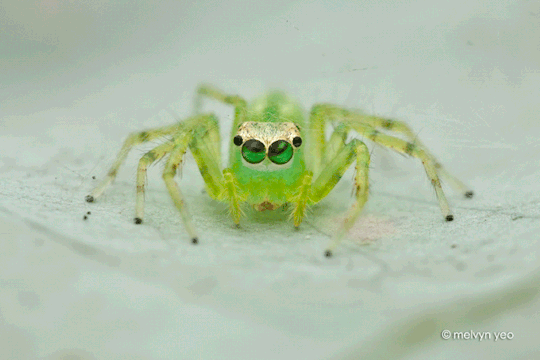
Random fact: Although jumping spiders can't move their eyes, they can move their retinas to change their field of view. It's as if they're looking through a window.

If the spider is clear enough, you can even see the retinas moving through the cephalothorax:
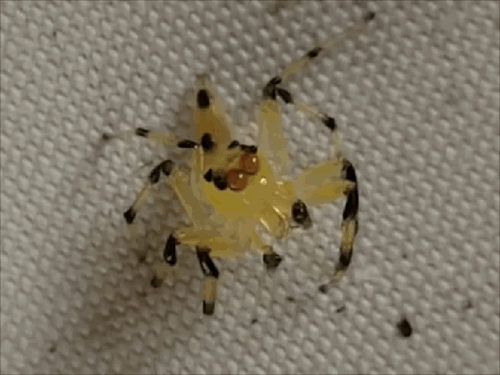
Image sources: Melvyn Yeo, M.F. Land, and wmaddisn
17K notes
·
View notes
Note
How hermaphrodite mammals elves could work? How any hermaphrodite mammals humanoid could work? How they could ever come into beging if we assume that gods guide evolution not create outright? How any isolated continent dominated by hermaphrodite mammals and birds and reptliles could work?
while I still can't find any official science community consensus on an alternative term for hermaphroditic species, I did find a new suggested word from 2024: "gonosimulism"
Gonosimulism - An alternative to ‘hermaphrodite’ in biology
Gonosimulistic - referring a sexually reproducing species in which all individuals produce both male and female gametes. Animal species in which individuals are either male or female (with intersex variation) are gonochoric, also spelled gonochoristic, which is the opposite of gonosimulistic.
Etymology
This term was derived from its antonym gonochoristic, or gonochoric, which has a meaning derived from Greek; (gone, (gono) meaning generation) + (chorizein (chori), meaning to separate) Gonosimulistic has similar etymology; derived from both Greek and Latin; (gone, (gono) meaning generation) + (simul, meaning to combine, or at the same time).
just a neat little bonus there, because I know the use of "hermaphrodite" has become a source of contention due to its history of being used as a derogatory term against intersex people. Likewise, I have also seen "agametic" as a new term to describe asexual reproduction, though I'm not sure it's commonly used yet. it's good to see changes like this.
Now, on to the actual question. Mammals that can effectively produce both eggs and sperm don't exist in reality, but in a fantasy world or an alien world, especially with explanations like a literal deity who could have created any living creatures or people they wanted, you have a lot more room for weirdness.
anatomical requirements:
if they're going to be capable of producing both eggs and sperm, and also be able to give birth, there's a lot of anatomy to deal with. This could be cut down by making them egg-laying mammals like the platypus, as they would not need a large womb to produce eggs.
you could also give them a cloaca, which is rather common outside of mammalian species, to simplify things just a bit more. They can still have a penis, as there are animals with both a cloaca and a penis. as long as they have some way to get the sperm into the uterus, they'll be fine.
ultimately, if you're going for evolutionary explanations, I would just say it's a good idea to look back at some prehistoric animals that existed before the modern mammals, such as early synapsids, as well as monotremes like the platypus. you can also look at non-mammalian animals that have unusual reproductive tactics. pretty much all the real world examples of things like gonosimulism will be fish, invertebrates, amphibians, and reptiles. it's not the same, but you could research parthenogenesis as well, which is the ability to produce cloned offspring.
if they're mammals, they'll also produce milk through mammary glands.
Worldbuilding:
in a people species that has no biological distinctions between male and female, they also probably wouldn't have any social concept of gender. their pronouns may be based on something else, like age or social status, if their language even bothers with distinct pronouns. They may have a preference for which reproductive role they take, or maybe they always do both at once with a bonded partner. there are a lot of ways to build up unique cultures around this idea.
any deities they worship would likely be depicted with the same anatomy, and if they met people who were strictly male and female, they'd probably be quite baffled.
how do they view each part of the reproductive process? how do their relationships work? what about childcare? etc.
hopefully that all helps with your worldbuilding! good luck
20 notes
·
View notes
Text
starting the careful process of moving posts over to another site for archive purposes. I actually find it easier to just copy paste things over, so I can be more thorough and picky about how it goes. luckily I can use tumblr's blog archive to see all my posts from specific months, allowing me to get to the oldest posts quickly so I don't have to scroll for five whole business days. I've been running this blog since late 2020, so a lot of answered asks and most of the posts critiquing or redesigning creatures from things like DnD will be left behind so I can focus on the more important original posts.
you can find it here!
so far I've only transferred the oldest posts where I redesigned the vrock. It is the creature design that got this blog going, so I'm keeping it even though it's a redesign. this copy-paste method might be a little tedious, but it also allowed me to consolidate several smaller posts into one very long post. I've also decided to start using my new author pseudonym there. when I eventually have published novels, they'll all be under the name Ava M. Gale. It just has a better flare and mystique to it than Miss M. Winks.
It's going to take a while before all my old posts are properly archived, but at least it gives me a space to retreat to if tumblr goes down for good.
22 notes
·
View notes
Text
Having any people species be inherently evil or inherently good just doesn't work in most fiction, in my opinion.
The more grounded the story is, the worse it feels to have default good guy and bad guy groups. And the more people try to use this trope, the more they end up using racist and ableist caricatures to describe their groups.
Default good guy people groups have a tendency to be beautiful and fair skinned, pale and golden haired, willowy, lovely, etc. Light and dark are the default symbols of good and evil, so the good must be light, and therfore they must have light features. They are usually the more civilized group, with the more elegant clothing and architecture, a wealth of scholars, soldiers with gleaming metal armor. They're more intelligent and clever, and they're probably ruled by a group of leaders or one really wise king or something.
And default bad guys tend to be dark. Dark skin, dark hair, dark eyes. Dark clothing that looks less refined, perhaps just tattered animal furs and decorative bones. Their architecture is usually poorly built or just made of rough hewn black stone. They're unintelligent, almost animalistic, they have asymmetrical features and lumpy, limping bodies. They're evil, so we have to make them look evil, and oh, don't think too hard about why these visual traits are "evil". They probably only have one or two intelligent leaders who are probably of a different species as well. Like the one evil person from the default good guy species. The evil species will often be described as brutish, savage, or barbaric. Etc.
If you find yourself writing distinct people groups in conflict with each other and they start to sound like any of the above, please stop and ask yourself why you are doing that.
And here are some solutions:
If you absolutely require a good group and an evil group, don't define them by their species. Mix it up. Focus more on their motivations and don't rely on common tropes as a shorthand for their good and evil natures. Being good or evil are both choices.
Or, maybe drop the clean cut good and evil thing and do something more nuanced. If you enjoy working with fictional politics, lean into it! Class inequality and systemic oppression that's not so reliant on one people group being inherently evil.
My takeaway from how people talk about memetic “bad” animals + continuous repetitive debate I see of orcs and goblins and devils etc etc in fantasy circles, is that we yearn to find an evil creature that deserves to die
987 notes
·
View notes
Text
About 10 years ago I was working for a gaming company doing creature design. After work, I would go home and dissect animals in my garage. I borrowed a tiger carcass from a local taxidermist. I wanted to understand how the jaw muscles worked, so I stop motion animated it.

The muscle on the back of the head (Temporalis) bulges out when the jaw is closed. But when the is jaw is open, it depresses in like the surface of a trampoline. But not uniformly, in a Y shaped pattern.

I ended up getting evicted for stop motion animating tiger parts in my garage…..but it was worth it. I still have hard drives full of animal carcasses reference animations today. Fun Times.
#animal death#dead animal#cw animal death#gore#cw gore#trying to cover my bases here#general anatomy#outside sources#feline#musculature
6K notes
·
View notes
Photo

Finally a Good drawing of a Vuxtean
259 notes
·
View notes
Note
Orc breast anon again. None-human reproductive biology and habits was one of the key things I’ve been trying to add to all my otherwise traditional fantasy beings for this current project. For some more examples…
Elves have the standard of low fertility and long pregnancies (about 14 months). However elven fertility is controlled partially by population and resources access, taking a nose dive if things get too stressful. Female elves are also taller and more socially dominant than men. Similar to goblins, elves have a strong cultural distinction between “romantic” & “reproductive” relationships, the elven concept of marriage being nothing more than a breeding contract, having no expectations of fidelity or romance.
Dwarves have little to no sexual dimorphism, both sexes being equally stout and hairy. Feminine characteristics like breast and wide hips only being visible when a dwarf women is pregnant, receding shortly after. Dwarf Soceity has no real gender roles, biological sex not being a factor in much of anything from work/ politics/ etc… . Dwarves are highly monogamous, things like infidelity and promiscuity are rare and seen as signs of mental illness. Dwarven monogamy is to the point that dwarves have greater emotional difficulty escaping toxic/abusive relationships, and in the case of a partners death the grieving spouse never remarries.
Ogres have a soceity similar to elephants, in that their Soceity is completely gender segregated and they only temporarily meet up to breed. Ogre women and children live together in settled communities, led the eldest female as matriarch. Ogre men are solitary nomads, kicked from their birth community by the time they become a teenager. The ogre religion strictly bans the union of genders, as a consequence of the ogre creation myth of the original male abusing the three original sisters and killing his progeny in jealously. He and his sons being forever cursed to wander the world as punishment for masculine ego.
Those are currently the most developed by their are more. Like trolls having wolf pack family dynamics/ fairies undergoing pupation to grow wings during puberty/ merfolk laying eggs like fish and harpies having exotic bird mating displays.
As for the brutality and “savagery” thing, I can see what you mean and how these traits may be misconstrued that way. My orcs and goblins are no less advanced then the other peoples,(being around a late renaissance era) having their own nations/ city states/ and so on. And that one of the main details I’m focusing on is that “Everyone is full of Sh*t”. All of the sapient beings in my world have problematic and barbaric practices, it not just being limited to the orcs and goblins. You got some universal issues like bigotry/ corporal punishment/ tyrannical leaders/ pointless wars/ widespread slavery/ etc… Then theirs some culture specific ones. Humans are ,ofcourse, very misogynistic as well and the major human empire is currently a colonizing and slavery based abusive superpower. Elves are practitioners of eugenics and purity culture, equating “beauty” with “moral goodness and spiritual purity”, with all the ugliness these entail. Dwarves have a rigid caste system ala dragon age, with no social mobility being possible except becoming a cast-less exile. Gnomes practice blood sacrifice and dark magics on a regular societal level. “serious STAY AWAY FROM THE GNOMES!!!”. And so much more.
This is all I’ve got for now of the current WIP of this project, and this has given me a lot to think about. Thank you once again for responding and your advice!
You've been putting a lot of work into this project! It's honestly really cool. I love seeing unique takes on fantasy people like this.
Having big issues in every group you write definitely helps balance things out! That's very good. You keep on having fun and building on your ideas!
29 notes
·
View notes
Text
Btw much as I love to make fun of twitter and reddit's business decisions, I have 0% trust in tumblr's management to not go a similar route so this is your gentle reminder that you should regularly go to your blog settings to export your blog. That's a fancy way of saying you can download a backup of your blog so if everything goes down you'll still have a backup of your posts & convos.
118K notes
·
View notes
Note
Orc breast anon. Thank you for answering. I’d thought I’d add some extra context about my orcs & goblins and some of the ideas I have currently on their reproductive biology and habits. See if their any suggestions or tips to help improve them.
My Orcs are your typical WoW/ Elder Scrolls kind (brutish and savage, but not innately evil). Orcs have an uneven gender ratio with more males then females, at a ratio of about 1-3. Orc women have induced fertility rather than a set fertility cycle, only needing an orgasm for pregnancy to occur. Twins and triplets are the norm for orc births, single births being rare and considered a bad omen. Orc women have between 4-6 breast, only the top set is really prominent, the bottom pairs being significantly smaller and only really growing in size when an orc women is either pregnant or overweight. Orc society is quite misogynistic and males being highly competitive, females being reduced to prizes to be won and not much else. The more wives and children you have the higher your social status among orc men. Orc men who are branded criminals/ cowards/ or otherwise shamed are castrated and made into borderline slaves, these eunuchs occupying the lowest rung of orc society.
My Goblins are also the typical variety, except they have a reproductive biology and society built like meerkats/mole rats. Goblin social structures are split between reproductive and none reproductive members, with the breeding females being at the top/ followed by their male mates/ and at the bottom the none breeding females and males. Breeding females birth whole litters of offspring, usually between 4-8 babies per batch. Goblins have induced fertility as well, but also the ability to be impregnated multiple times, each litter having multiple genetic fathers. Goblin women have 8 nipples, though breast are only visible on the breeding females due to a mix of hormones and repeated pregnancies. Babies are only kept by the bio mother until weaned, after which they’re handed off to care takers to finish raising them. These lower goblin care takers are who name the children/ assign them a future role and social class/ and other prominent parental duties. Even in more liberal goblin societies is seen as highly taboo for a goblin women to get pregnant without being ascended to breeding status, often being punished brutally. In the best case the mother and her offspring will be branded and banished, at worse the mothers sterilized and her babies killed before her in the more tyrannical goblin cultures.
I think the biology you've worked out for them is great! It's always fun to see fantasy people that have unique non human biology and reproductive habits. I've done similar with my own drow, basing their reproductive habits and social roles on the eusocial naked mole rats even though they're primates. Like if baboons were people but also eusocial cave creatures haha.
Meerkat goblins are a really fun idea, I love that.
I do have some personal concerns about the fact that you're portraying both of these groups as "brutish and savage" in some way or another, but I understand that you're going for a more common expectation with how they're usually portrayed.
Thing is, words like brutish, savage, and barbaric, while they don't necessarily always mean "innately evil" have still been used irl to describe indigenous people in many parts of the world, as an excuse to colonize their lands and "fix" them or eradicate them because they're "uncivilized". So at the very least I'm going to just caution you on how you're portraying these fantasy people and ask that you double check your worldbuilding for any parallels to real life groups.
Here are a few questions to help you check your writing:
Are the orcs and goblins the only groups that show this level of misogyny? Are they the only ones who are this strict and harsh with their social hierarchies? Do other groups in your world, like elves, also have extreme negative social traits like this?
What does the architecture look like for the orcs and goblins? How about their clothing and tools? What unique advancements do they have that other people do not? Or are they significantly less advanced than other people? Are their homes and clothing simple in a reasonable way or in a way that makes them look almost useless?
Even if you're not portraying orcs and goblins as outright evil, do you give them space to show good and positive traits as well? Do you portray other people with a higher number of positive traits in comparison?
My purpose with this blog is not to stop anyone from following their own ideas, but since I have advocated for more nuanced portrayals of all fantasy people, I feel some obligation to warn you that the way you've described your orcs and goblins will probably feel rather racist to some audiences.
But I'm also an advocate for fantasy that explores darker topics, so if you think you can handle these portrayals with nuance and make it work, then all power to you.
I myself have written orcs to have a history of hunting centaurs, and that history is messy and bloody and full of questions about where the line can be drawn between animals performing natural behaviors in a morally neutral manner, and people behaving cruelly. So I'm not going to tell you you have to drop all the negative aspects of these orc and goblin portrayals and make them super nice and good, that's not really how trope subversion works. I'll just tell you to make sure you're not leaning so hard into the negative traits that it overpowers any positive trials they might have. Be nuanced with them! They're still people.
15 notes
·
View notes
Note
So, with the elves again...Mine have thin, hollow bones (which is the reason for their gracile statures) and only adults have wings (which are partially magical and a secondary sexual characteristic, with males having long narrow ones for speed and endurance, female round and slightly concave ones for power lifting and maneuverability with more androgynous individuals having something in between. Their fleshy areas tend to be, in adults, slightly stronger than in humans.) How would corporal punishment work in such cultures, when they don't want handicap the person. Also, the shoulder blade area is a universal taboo to harm (kind of how all human cultures have some form of music ). I think of martinet on the laps and irritants applied to non-sensory essential but pain-sensitive areas.
Hmmmm okay so. If we are talking about corporal punishment on a law enforcement and military type of level, I'm not so sure they would be concerned about preventing disabling injuries or avoiding a body part that's usually off limits.
Corporal punishment is not an effective behavioral correction tool. Its only purpose is causing harm and inducing fear, and often times "making an example" out of someone to frighten everyone else.
Historically, you might see such punishments as cutting off a thief's fingers, whippings, various forms of torture. These are not punishments done with the intention of letting the victim heal up and continue living a normal life with a few scars.
In the case of having a "taboo" against hurting a specific body part, I can actually see that becoming a high level form of corporal punishment. If someone is intentionally seriously injured in the one place you're never supposed to hurt, isn't that a great way to mark them as particularly terrible criminal? Or a great way to show your power by doing it to your enemies? I would think any authority that uses corporal punishment would actually cause disabling injuries on purpose to make an example out of the people they hate the most. Even to the point of cutting off whole wings, or at least enough of the wing to ground someone without fully killing them, leaving them horribly maimed so anyone who sees them will be terrified of ending up with the same punishment. Death sentences are also a form of corporal punishment.
The less disabling punishments like the ones you mentioned above would likely be used for smaller offenses, or torture tactics.
If you're writing a society where corporal punishment exists at all, you should really think about why the people in charge of ordering and executing those punishments would only want to cause mild harm. And if the answer is that you as the writer are uncomfortable making a society that allows harsher corporal punishment, then perhaps you need to rework the worldbuilding and avoid writing any corporal punishments.
I would recommend researching how criminal rehabilitation works, the psychology around positive reinforcement, and which countries have the lowest crime rates and how they manage it. That will give you an idea of some better alternatives to corporal punishment if it's something you're not so comfortable keeping in your worldbuilding.
And if you are comfortable keeping it in your worldbuilding, then don't hold back so much. It's a method of punishment that intentionally causes harm, so write it that way. It can be used to show what the political climate is like in your world, how the societal hierarchies work, and what sorts of crimes are considered the worst in this culture based on how horrible the punishments are.
18 notes
·
View notes
Note
It's me again. My blog is empty because I'm never intented to use my tumblr account to anything ither that asking questions. I don't making AI because I hate AI . I'm sorry about my questions about slavery. And Im sorry for my panic post about that Im not AI . ITS IS TRUE but I should tell you more. I'm sorry .
Hi there. Thanks for clarifying. If you don't want people to think you are a bot, it really helps to do a few things with your blog!
Change the profile image and header so they're not the default. Follow people you like to see the posts of! Click that little heart on posts you enjoy. Reblog some posts! You don't need to post original content to have a blog that looks like a real person is using it. Fact of the matter is that if your blog is empty and your only action is to send questions to people, it's going to start looking like you're a bot.
I will delete the post about my concerns, but please consider using your blog more so people don't block and report it. Especially now that ai is so prevalent, I know a lot of tumblr users are quick to block and report empty blogs.
I really only checked your blog in the first place because you had sent multiple asks and I wanted to see if you were a fellow writer and maybe I would be able to see your work too, send a few questions back to be social.
Finding it so empty that you didn't even have any likes or follow anyone outside of staff was extremely disconcerting. Also by the way you can turn off the option for people to see your likes and following list, if you'd rather keep those private.
Seems like maybe you're still feeling new to tumblr and haven't figured out how it works? So I'm just going to encourage you to follow some people who post things you enjoy and reblog their posts, because that's how we build a good social life on tumblr.
14 notes
·
View notes
Note
I know this is an odd question, but do you have any advice on how to design humanoids with multiple nipples without it seeming “weird”?
For context I’m trying to design orcs and goblins for my realm, that they breed rapidly compared to all the other peoples due to them both birthing litters rather than single births. And that because orc and goblin women are mammals & produce multiple offspring they possess multiple nipples to nurse all their offspring. However I’m running into issues as to how to design this, without it looking like fetish material.
Is their any way to have multiple breast on a humanoid without it looking like “dare ye enter my magical realm” ? or is it just “it’s only weird if you make it weird” and I’m overthinking things?
I swear, ages ago on tumblr, I once saw a very useful diagram comparing the locations of the nipples on a wide variety of mammals. and now my internet search history is flooded with desperate attempts to find it again, and I can't find it anywhere.
Best I found was a very low quality image showing where the "milk lines" or "mammary ridge" can be lined up on a human torso. I also learned that the highest number of mammaries on any animal is pigs with 18. Generally, the number of mammary glands should be twice as much as the expected number of babies the species can produce at once. Humans usually only have one baby at a time, so we have two mammary glands. But then also, like, cows have four teats and usually only have one baby as well. I think for the sake of fantasy, we can fudge this rule a little bit, who cares. My drow have twins almost exclusively, but since they're still primates they only have two mammary glands. It's easier for evolution to remove things than to add them, usually.
anyway here's a redraw of that low quality diagram I found:

(image description: sketched human torso with red lines curving inward from just above the breasts to just over the groin. there are small marks on the lines to show several potential nipple locations, with a total of 6 pairs of nipples including the normal ones. end description.)
Personally when I've drawn people species that have extra breasts/nipples, I stop at three pairs, and I could push it to four without feeling like I'm overdoing it lol. You can do a few different things with the sizes of the breasts. Bigger ones in priority locations, smaller ones everywhere else. Breasts that are usually flat but get larger during pregnancy and remain large until babies are weaned. all the breasts could be the same size. etc.
Remember that breasts sag! they're squishy and saggy and they will probably hang to the side instead of straight down. if they're laying on top of each other they're gonna be a real sweaty mess and they will not be all perky and round like a bunch of balloons.



(image description: sketch of a humanoid figure with red lines and dots to represent breasts and nipples. There are three pairs altogether. the first image shows all the breasts completely flat, the second image shows only the top pair of breasts being large, and the final image shows a full three pairs of breasts sagging on top of each other. end description)
45 notes
·
View notes
Text
Ugh the fresh concerns about losing tumblr are so annoying because backing up my blogs is such a pain and no other website gives me the same stuff tumblr does.
I might just go through my main posts and try to copy them over onto some sort of blogging site. At least I'll be able to archive my longest posts that way. Just gotta find a blogging site that's free to use and allows for integrated photo and text posts. It's going to be such a stupidly tedious process.
23 notes
·
View notes
Note
I am wrighting elves as being winged creatures, with their wings being chitin containing very human-looking nerves, bloodvessles, cartilage and later on bone. It's also an erogenous zone. How should I draw the nerves into the design ?
oh, I thought I had lost this ask to tumblr's weird beasts, it vanished when i was last emptying the inbox! but it has been released from purgatory, i guess.
Whether they're nerves or veins, this description reminds me of insect wings, which have very visible veins and struts all through them. The struts just help strengthen the wing, which is why high speed insects like dragonflies have a dense grid of them to reduce the wear and tear.

(image description: diagram of different types of insect wings, showing the veins and other structures that act like a frame for the wing. end description.)
25 notes
·
View notes
Text
Here's some notes on some of the upper body muscles so you, artist, don't need to look them up

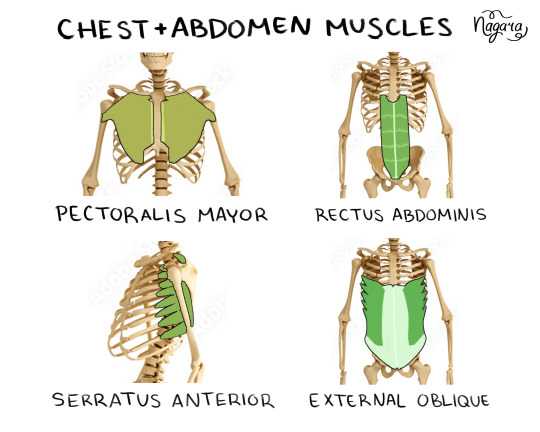
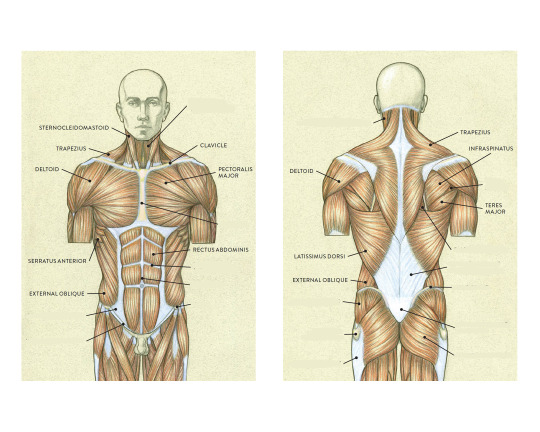



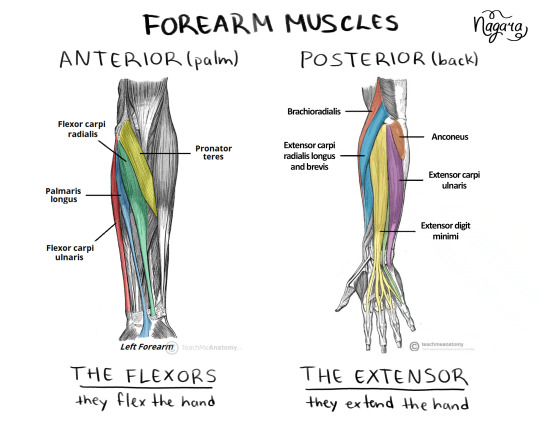

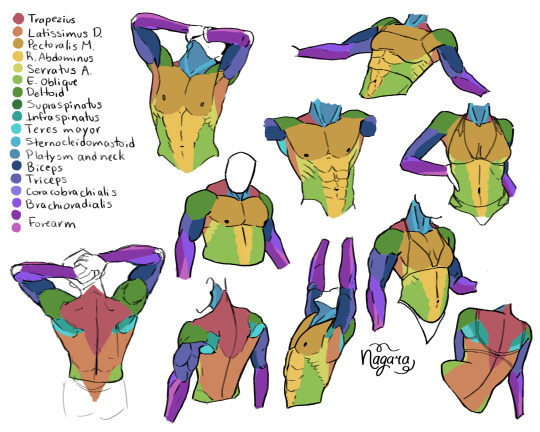
They are not medically accurate, just enough for artists to know the necessary muscles and how they work together
I 100% recommend doing the last exercise I did to be able to actually place the muscles
46K notes
·
View notes
Text
How to draw gorgon hair
,coHi, I have a question about how to draw gorgon hair, which can apply to any being with tendrils growing out of their heads, like the Nautolan alien species from Star Wars.
When trying to draw a gorgon with snake-hair I’ve noticed a problem which will be illustrated using this image:

1. I’ve given an example of how most people draw gorgon hair: The snakes are placed in a way that they resemble swept back locs, the bodies cover the scalp.
2. I’m illustrated something I’ve realized: when there’s a single layer of snakes and they are raised, it would leave most of the scalp bare which looks a bit ridiculous.
3. In order to avoid this, there needs to be multiple layers of snakes along the scalp from hairline to nape, but that would create the problem of being very heavy due to the sheer weight of so many snakes.
I want to ask for advice on how to draw a gorgon with a headful of snakes in a way that’s simple and aesthetically pleasing.
---
a fascinating question! for the sake of the fantasy, we will ignore the extra complication of how to attach a bunch of snake skeletons to a humanoid skull. this is one of those fantasy anatomy things that just has to be handwaved. not everything can be perfectly believable lol.
when we look at the hairstyles present in old greek and roman art, there is at least evidence that these people know how to make some intricate braids/plaits.
this video here goes over some art that shows a fishtail braid hairstyle, as well as other hairstyles in greek art:
youtube
and here is a tumblr post about greek hairstyles that resemble locks
and an archived book of historical drawings that show a lot of different hairstyles from around the broader mediterranean region
it’s also important to remember that greece had cultural exchange with egypt, so I don’t think it would be unreasonable to reference some black hairstyles for gorgon snake hair, especially when you consider how many hairstyles in several different african cultures do utilize thick braids or carefully sectioned knots of hair, which is exactly the sort of hair-grid reference that would be useful for placing a bunch of snakes on a humanoid head. you want each snake body to have space around itself so they can move efficiently.
my first thought was actually to look up images of bantu knots, because I know they show off the sort of clean geometric hair grids that would be useful here. just how many snakes you can fit on a gorgon’s head depends on whether you’re going with big chunky boas or smaller, skinny snakes like garter snakes. bantu knots can be done in a lot of sizes, tiny or huge.
here are a couple of examples: (sourced from an article on stylecraze.com)


(image description: photos taken from the top and back of people’s heads to show off their bantu knot hairstyles. end description)
if you think of the snakes more like braids that move, it might help you figure out how to arrange them better according to your preference. fewer snakes may actually be the better option in some cases! or you could space them differently, like a mohawk of snakes.
You could also vary the size of the snakes based on location. bigger snakes towards the middle and lower back of the head, smaller snakes closer to the front and top.

(image description: sketches of a gorgon showing the snakes having different sizes on different parts of the head. end description)
there are a lot of ways to do it! personally I also don’t mind the undercut style you showed in the original drawings, where the head is bald in the back under a curtain of snakes, so it’s very much down to personal preference! just have fun with it :)
28 notes
·
View notes